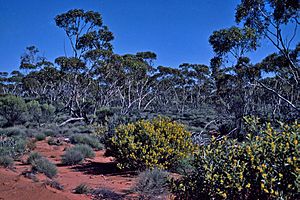Boorabbin mallee facts for kids
Quick facts for kids Boorabbin mallee |
|
|---|---|
 |
|
| Eucalyptus platycorys near Kichener, east of Kalgoorlie | |
| Scientific classification | |
| Genus: |
Eucalyptus
|
| Species: |
platycorys
|
The Eucalyptus platycorys, also known as the Boorabbin mallee, is a special type of plant. It is usually a mallee, which means it's a shrub or small tree with many stems growing from the ground. Sometimes, it can grow into a small tree. This plant is found only in Western Australia. It has rough, dark grey bark on its trunk that looks like it's peeling off. Higher up, the bark is smooth and grey. Its leaves are shaped like a spear, and its flowers are a creamy white color. The plant also produces cup-shaped fruits.
Contents
What Does Boorabbin Mallee Look Like?
The Boorabbin mallee usually grows as a mallee, which is a plant with many stems coming from a special woody base called a lignotuber. This lignotuber helps the plant regrow after fires. It can grow to be about 2 to 12 meters (6 to 39 feet) tall. The bark on the lower part of the trunk is rough, dark grey, and flaky. Higher up, the bark is smooth and greyish, often peeling off in long strips.
- Leaves
Young plants and new shoots (called coppice regrowth) have dull, bluish-green leaves. These leaves are lance-shaped, about 60 to 100 millimeters (2.4 to 3.9 inches) long and 15 to 40 millimeters (0.6 to 1.6 inches) wide. Adult leaves are shiny green on both sides. They are also lance-shaped, measuring about 70 to 140 millimeters (2.8 to 5.5 inches) long and 8 to 23 millimeters (0.3 to 0.9 inches) wide. They narrow down to a stalk called a petiole, which is 10 to 30 millimeters (0.4 to 1.2 inches) long.
- Flowers
The flower buds grow in the leaf axils, which are the spots where the leaf joins the stem. They usually appear in groups of three. Each group grows on a stem called a peduncle, which is 3 to 15 millimeters (0.1 to 0.6 inches) long. Each individual bud has its own small stalk, called a pedicel, about 1 to 6 millimeters (0.04 to 0.24 inches) long.
Mature buds are shaped like a cylinder and are bright red before they open. They are about 8 to 17 millimeters (0.3 to 0.7 inches) long and 6 to 10 millimeters (0.2 to 0.4 inches) wide. The top part of the bud, which acts like a cap, is called an operculum. It can be cone-shaped or have a beak-like tip. The Boorabbin mallee mostly flowers from July to October, and its flowers are creamy white.
- Fruit
After flowering, the plant produces a woody fruit. This fruit is a capsule that is shaped like a cup or a cylinder. The parts that open to release the seeds, called valves, are at the same level as the rim of the fruit or slightly below it.
How it Got its Name
The Boorabbin mallee was first officially described in 1929. Two botanists, Joseph Maiden and William Blakely, wrote about it in Maiden's book, A Critical Revision of the Genus Eucalyptus. They studied plant samples collected near Boorabbin by another botanist named Alexander Morrison.
The scientific name platycorys comes from ancient Greek words. "Platy" means "flat," "wide," or "broad," and "corys" means "helmet." This name refers to the operculum (the cap of the flower bud), which is wider than the base of the bud.
Where Boorabbin Mallee Lives
The Boorabbin mallee is found in different parts of Western Australia. It grows in sandy areas, including sand lakes, sandplains, and sand dunes. You can find it from the town of Boorabbin all the way to Ravensthorpe. It also grows further east, reaching the Fraser Range and the western edge of the Great Victoria Desert.
Is it Endangered?
The Western Australian Government's Department of Parks and Wildlife has looked at the Boorabbin mallee. They have classified this eucalypt as "not threatened." This means it is not currently at risk of disappearing.

